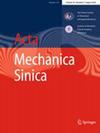A new method for simultaneous measurement of flow velocity and temperature using phosphorescent particle tracking velocimetry
Abstract
This study combines particle tracking velocimetry and thermographic phosphor thermometry to develop a new method for simultaneously measuring the flow field velocity and temperature based on the decay lifetime of phosphor particles. In this method, phosphor particles are used as tracer particles. Velocity is measured by tracking the position of the phosphor particles, and temperature is determined by obtaining the decay lifetime from multi-frame tracking of the particles’ luminescence information, achieving instantaneous and simultaneous measurements. This paper analyzes the influence of the intensity characteristics of the phosphor particles and the number of frames used in particle tracking on the temperature measurement precision. The findings indicate that using the mean intensity from a local window of the particle to calculate the temperature yields higher precision than the maximum intensity. Furthermore, increasing the number of frames used for particle tracking within a specified range enhances the precision of the temperature measurement. Calibration results over a temperature range of 20 °C–180 °C show that the uncertainty of the phosphorescence decay slope constant is 3.5%–4.4%, indicating high-precision temperature measurements. Finally, the proposed method is experimentally validated by capturing the instantaneous velocity and temperature field of a cold jet flow. Based on the simultaneous measurement results, the turbulent heat flux of the flow field is determined, revealing that the heat exchange is most intense near the jet shear layer. These results confirm the method’s feasibility and its potential in studying multi-physics complex flow problems.

 求助内容:
求助内容: 应助结果提醒方式:
应助结果提醒方式:


